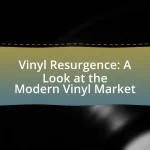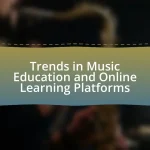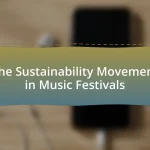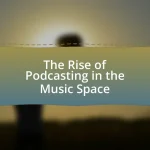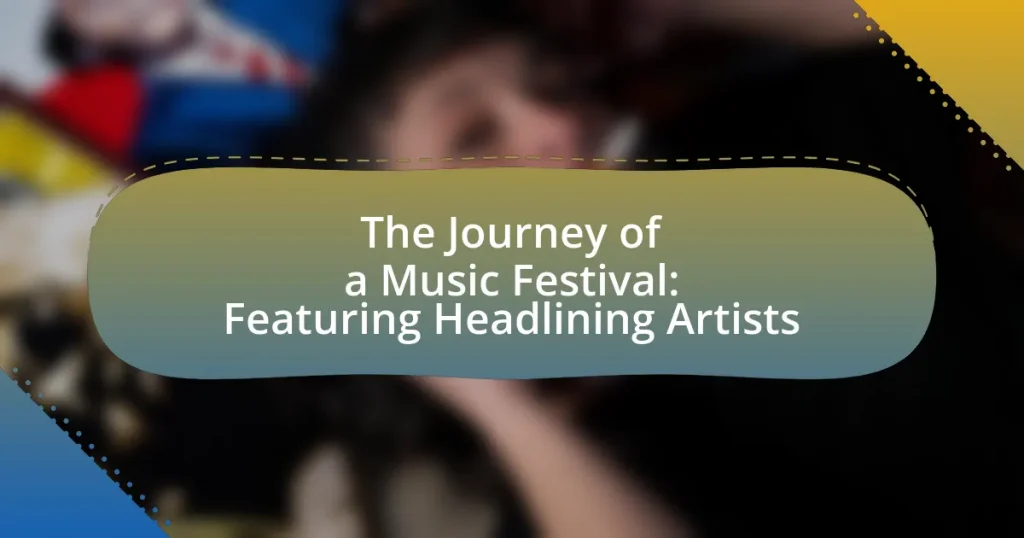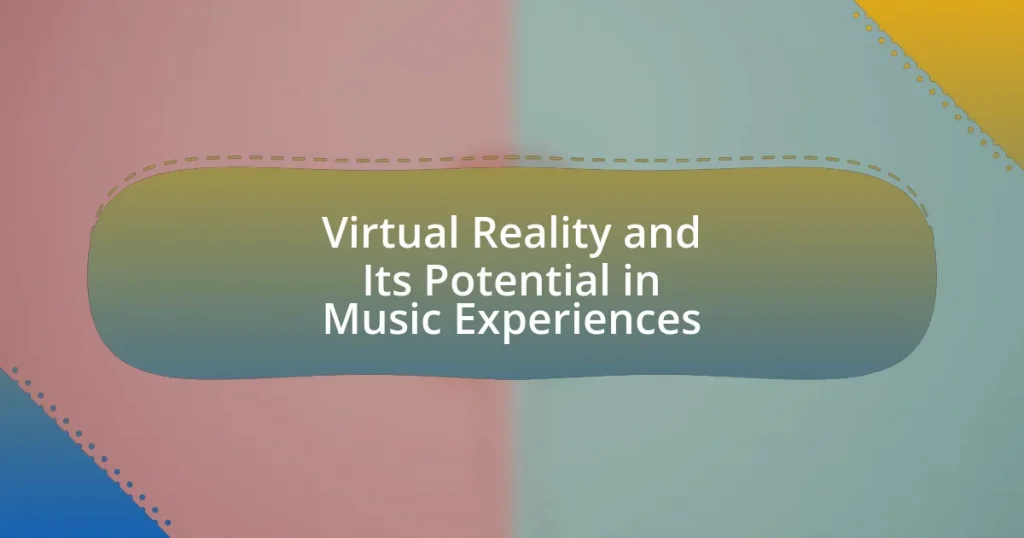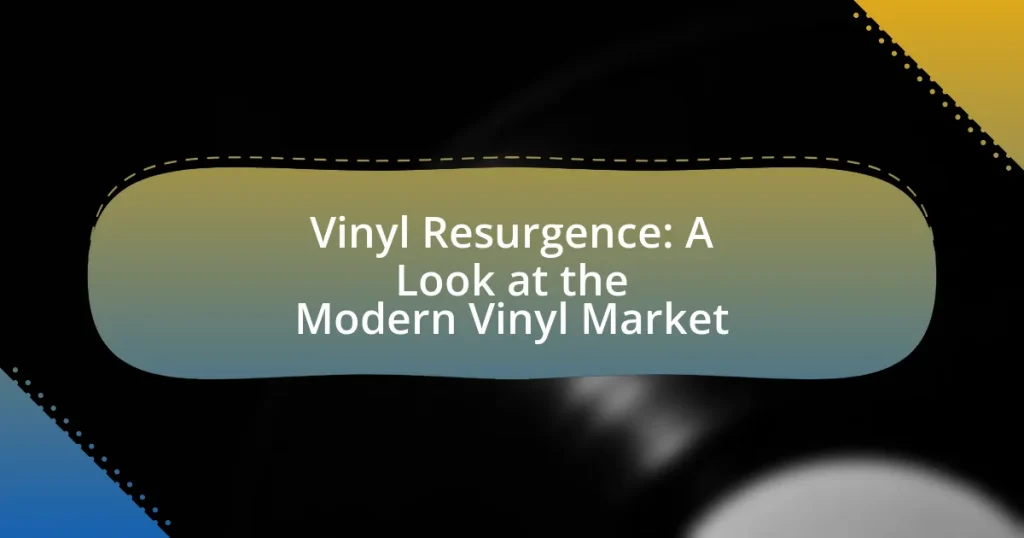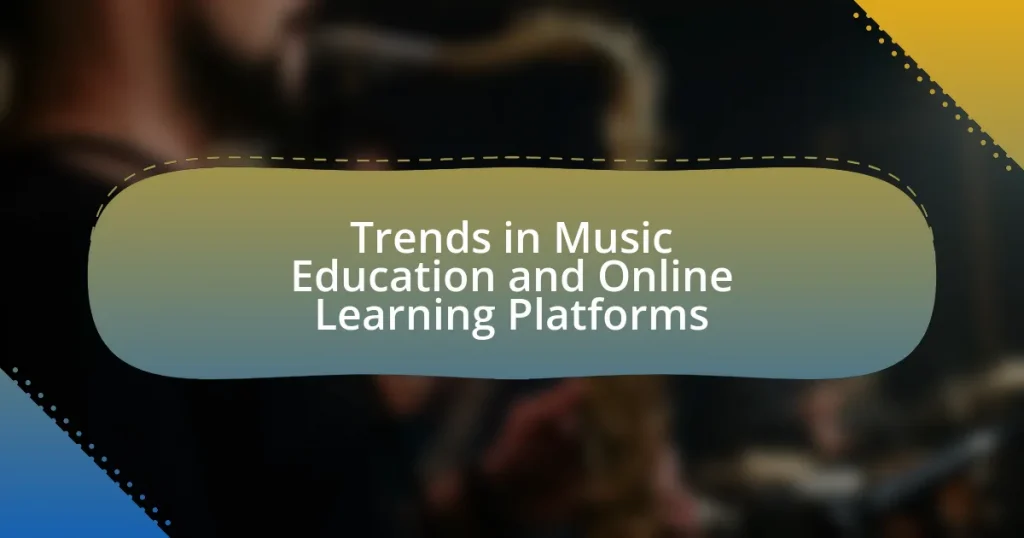The article focuses on the journey of a music festival, detailing the essential stages from conceptualization and planning to execution and evaluation. It highlights the significance of headlining artists in attracting audiences and enhancing the festival’s brand and reputation. Additionally, the article explores how music festivals evolve over time, influenced by cultural trends, audience demographics, and technological advancements. Key logistical considerations, financial risks, and environmental impacts are also discussed, along with best practices for both organizers and attendees to ensure a successful festival experience.
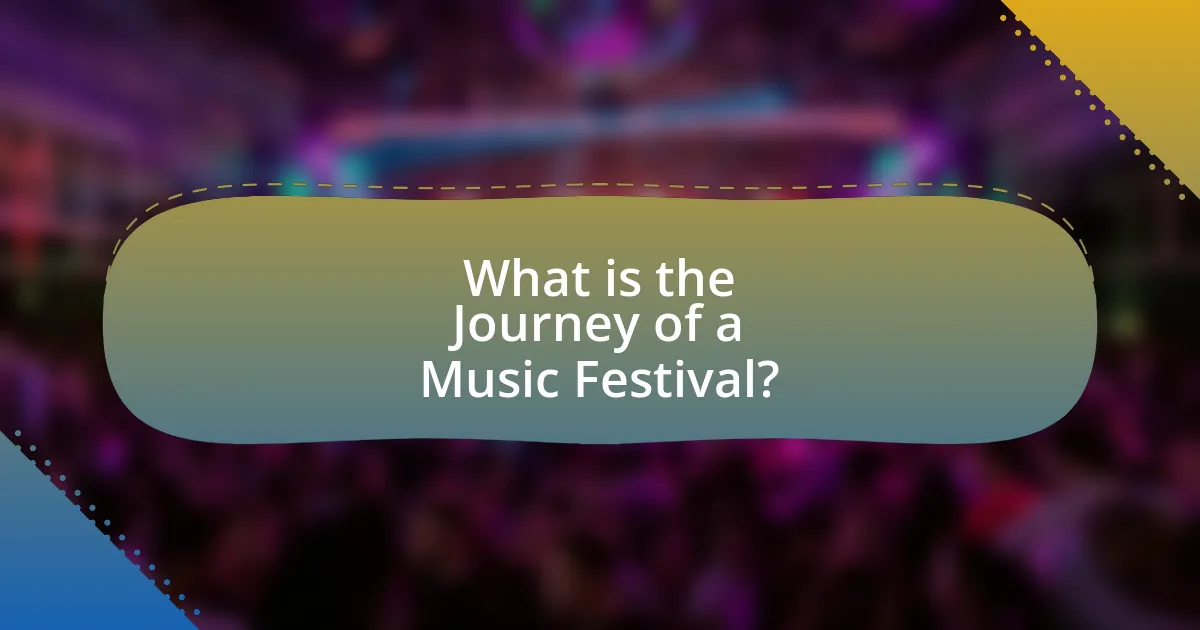
What is the Journey of a Music Festival?
The journey of a music festival begins with the conceptualization and planning phase, where organizers select a theme, secure a location, and book headlining artists. This phase is crucial as it sets the foundation for the festival’s identity and appeal. Following planning, the next step involves marketing and ticket sales, which are essential for generating interest and revenue. Successful festivals often utilize social media and partnerships to reach a wider audience.
As the festival date approaches, logistical arrangements such as stage construction, sound and lighting setup, and vendor coordination take place. These elements are vital for ensuring a smooth experience for attendees. On the festival day, the journey culminates in live performances, where headlining artists engage with the audience, creating memorable experiences.
Post-festival, organizers typically conduct evaluations to assess success and gather feedback, which informs future events. This cyclical process highlights the dynamic nature of music festivals, emphasizing the importance of planning, execution, and reflection in their journey.
How do music festivals evolve over time?
Music festivals evolve over time through changes in musical genres, audience demographics, and technological advancements. Initially, festivals often focused on specific genres, such as rock or folk, but have diversified to include a wide range of music styles, catering to broader audiences. For example, the emergence of electronic dance music in the 2000s led to festivals like Tomorrowland and Ultra Music Festival, which attracted younger crowds and expanded the festival landscape.
Additionally, audience demographics have shifted, with festivals now appealing to families and diverse age groups, as seen in events like Coachella, which features a mix of mainstream and indie artists. Technological advancements, such as live streaming and social media promotion, have also transformed how festivals are experienced and marketed, allowing for global participation and engagement. These factors collectively illustrate the dynamic nature of music festivals as they adapt to cultural trends and technological innovations.
What are the key stages in the development of a music festival?
The key stages in the development of a music festival include conceptualization, planning, promotion, execution, and evaluation. Conceptualization involves defining the festival’s theme, target audience, and location. Planning encompasses securing permits, booking artists, and arranging logistics such as stage setup and vendor contracts. Promotion focuses on marketing the event through various channels to attract attendees. Execution is the actual event management, ensuring everything runs smoothly on the festival days. Finally, evaluation involves assessing the festival’s success through attendee feedback and financial analysis to inform future events. Each stage is critical for the overall success and sustainability of the festival.
How do cultural trends influence the evolution of music festivals?
Cultural trends significantly influence the evolution of music festivals by shaping their themes, lineups, and overall experiences. For instance, the rise of social media has led to festivals incorporating interactive elements and visual aesthetics that encourage attendees to share their experiences online, thus enhancing visibility and engagement. Additionally, the increasing focus on sustainability and social justice has prompted many festivals to adopt eco-friendly practices and promote diverse lineups, reflecting broader societal values. Historical examples include the emergence of Coachella in the late 1990s, which embraced a blend of music genres and fashion trends, setting a precedent for future festivals to prioritize cultural relevance and inclusivity.
Why are headlining artists important to music festivals?
Headlining artists are crucial to music festivals because they attract large audiences and drive ticket sales. Their established fan bases and mainstream recognition create significant buzz, which enhances the festival’s visibility and reputation. For instance, major festivals like Coachella and Lollapalooza often feature top-tier artists, resulting in record attendance and substantial economic impact, with Coachella generating over $700 million for the local economy in 2019. This demonstrates that headlining artists not only elevate the festival experience but also contribute significantly to its financial success and cultural relevance.
What role do headlining artists play in attracting attendees?
Headlining artists play a crucial role in attracting attendees to music festivals by serving as the primary draw for the event. Their established fan base and popularity create significant anticipation and interest, leading to increased ticket sales. For instance, festivals like Coachella and Lollapalooza often feature top-tier artists, which can result in attendance numbers reaching over 100,000 people. This phenomenon is supported by data showing that festivals with well-known headliners typically sell out faster than those without, demonstrating the direct correlation between artist recognition and attendee turnout.
How do headlining artists impact the festival’s brand and reputation?
Headlining artists significantly enhance a festival’s brand and reputation by attracting larger audiences and generating media attention. Their established fan bases often lead to increased ticket sales, as fans are more likely to attend events featuring well-known performers. For instance, festivals like Coachella and Lollapalooza have seen substantial growth in attendance and sponsorship deals when they feature high-profile artists, such as Beyoncé and Kendrick Lamar. This association with popular headliners elevates the festival’s status in the competitive landscape of music events, reinforcing its brand identity and appeal.
What are the common elements of a successful music festival?
A successful music festival typically includes a diverse lineup of artists, effective organization, and a vibrant atmosphere. The diversity in the lineup attracts a wider audience, as seen in festivals like Coachella, which features genres ranging from rock to hip-hop, appealing to various musical tastes. Effective organization encompasses logistics such as crowd management, safety protocols, and scheduling, which are crucial for a seamless experience; for instance, Glastonbury’s meticulous planning has contributed to its reputation as one of the best festivals globally. Lastly, a vibrant atmosphere, created through engaging activities, art installations, and food options, enhances attendee enjoyment, as evidenced by the immersive experiences at festivals like Burning Man. These elements collectively contribute to the overall success and popularity of music festivals.
How does the festival location affect its success?
The festival location significantly affects its success by influencing attendance, accessibility, and overall experience. A strategically chosen location can attract larger crowds due to its proximity to major transportation hubs, accommodations, and local attractions. For instance, festivals held in urban areas often benefit from higher foot traffic and easier access for attendees, leading to increased ticket sales. Additionally, the local culture and environment can enhance the festival’s appeal; for example, a scenic outdoor venue can create a memorable atmosphere that encourages repeat attendance. Studies have shown that festivals in well-connected locations can see attendance rates increase by up to 30% compared to those in remote areas, demonstrating the critical role location plays in a festival’s overall success.
What logistical considerations are crucial for festival planning?
Crucial logistical considerations for festival planning include site selection, crowd management, transportation, vendor coordination, and safety protocols. Site selection involves assessing location accessibility, capacity, and amenities, which directly impacts attendee experience and operational efficiency. Crowd management strategies, such as entry and exit points, help ensure safety and smooth flow during peak times. Transportation logistics, including parking and shuttle services, are essential for accommodating attendees and artists. Vendor coordination ensures that food, merchandise, and services meet demand and quality standards. Lastly, safety protocols, including emergency response plans and security measures, are vital for protecting attendees and staff, as evidenced by the implementation of comprehensive safety plans in large-scale events like Coachella and Glastonbury.
How do music festivals select their headlining artists?
Music festivals select their headlining artists based on a combination of factors including popularity, marketability, and genre alignment. Festivals often analyze ticket sales data, streaming statistics, and social media presence to identify artists with significant fan bases. Additionally, the festival’s theme and target audience influence the selection process, ensuring that headliners resonate with attendees. For instance, major festivals like Coachella and Glastonbury have historically chosen artists who not only have chart-topping hits but also cultural relevance, as seen with headliners like Beyoncé and Radiohead, who attracted large crowds and media attention.
What factors influence the booking of headlining artists?
The booking of headlining artists is influenced by several key factors, including market demand, artist popularity, financial considerations, and logistical requirements. Market demand dictates which artists are sought after based on current trends and audience preferences, while artist popularity is often measured through metrics such as streaming numbers, social media following, and past ticket sales. Financial considerations involve the budget allocated for artist fees, which can vary significantly based on the artist’s stature and expected draw. Logistical requirements encompass the availability of the artist, their touring schedule, and technical needs for performance. These factors collectively determine the feasibility and success of booking a headlining artist for a music festival.
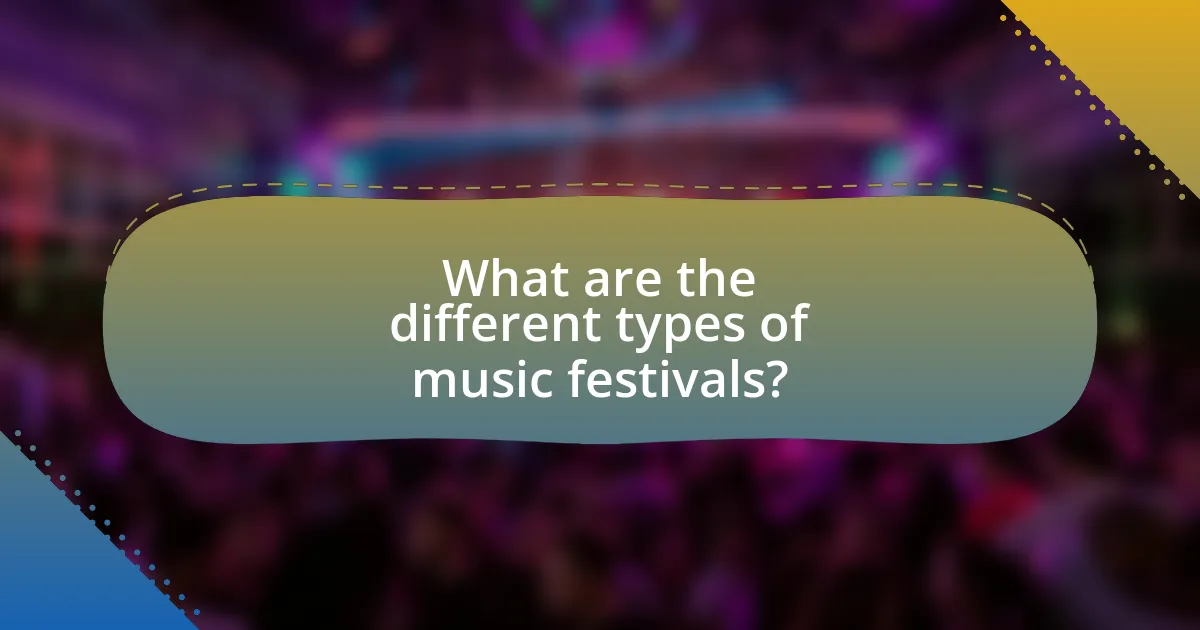
What are the different types of music festivals?
There are several types of music festivals, including genre-specific festivals, multi-genre festivals, and cultural festivals. Genre-specific festivals focus on a particular music style, such as rock, jazz, or electronic dance music, attracting fans of that genre. Multi-genre festivals feature a diverse lineup of artists across various music styles, appealing to a broader audience. Cultural festivals celebrate specific cultural heritages and often include music as a key component, showcasing traditional and contemporary sounds from that culture. Each type of festival serves to connect artists with audiences, enhance community engagement, and promote musical diversity.
How do genre-specific festivals differ from multi-genre festivals?
Genre-specific festivals focus on a single music genre, such as jazz, rock, or electronic, while multi-genre festivals showcase a variety of genres within one event. This distinction influences the audience experience, as genre-specific festivals attract fans deeply invested in that particular style, often featuring artists who are prominent within that genre. For example, the Montreux Jazz Festival primarily highlights jazz and blues artists, creating a niche atmosphere. In contrast, multi-genre festivals like Coachella present a diverse lineup, appealing to a broader audience and allowing for cross-genre collaborations. This variety can enhance the festival’s appeal but may dilute the focused experience found in genre-specific events.
What are the unique features of genre-specific music festivals?
Genre-specific music festivals are characterized by their focused curation of artists and performances that align with a particular musical genre, creating a cohesive experience for attendees. These festivals often feature lineups that include both established and emerging artists within the genre, enhancing the authenticity and appeal of the event. For example, a jazz festival will showcase a variety of jazz musicians, from traditional to contemporary styles, allowing fans to explore the genre’s diversity. Additionally, genre-specific festivals typically incorporate themed activities, workshops, and discussions that deepen the audience’s engagement with the music and culture associated with that genre. This targeted approach not only attracts dedicated fans but also fosters a sense of community among attendees who share similar musical interests.
How do multi-genre festivals cater to diverse audiences?
Multi-genre festivals cater to diverse audiences by offering a wide range of musical styles and performances that appeal to various tastes and preferences. These festivals typically feature artists from different genres such as rock, hip-hop, electronic, and folk, ensuring that attendees can enjoy multiple types of music in one event. For example, festivals like Coachella and Glastonbury showcase a diverse lineup that attracts fans from different demographic backgrounds, enhancing the overall experience and fostering inclusivity. This variety not only broadens the audience base but also encourages cross-genre exploration, allowing attendees to discover new artists and styles they may not have encountered otherwise.
What are some notable examples of music festivals worldwide?
Notable examples of music festivals worldwide include Coachella in the United States, Glastonbury in the United Kingdom, Tomorrowland in Belgium, and Lollapalooza, which has multiple locations including Chicago and Brazil. Coachella, held annually in California, attracts over 250,000 attendees and features a diverse lineup of artists across genres. Glastonbury, known for its iconic pyramid stage, has been a staple of the UK music scene since 1970 and draws around 200,000 festival-goers. Tomorrowland, celebrated for its elaborate stage designs and electronic music focus, hosts approximately 400,000 attendees over two weekends. Lollapalooza, originally founded in 1991, has expanded globally and showcases a wide range of musical acts, drawing large crowds in each of its locations.
How do these festivals showcase headlining artists?
Festivals showcase headlining artists through prominent stage placements, extensive marketing, and exclusive performances. Headlining artists typically perform at peak times, often closing the festival or taking the main stage, which maximizes audience exposure. Additionally, festivals invest in marketing campaigns that highlight these artists, using social media, advertisements, and promotional materials to attract attendees. For instance, major festivals like Coachella and Lollapalooza prominently feature headliners in their lineups, which significantly boosts ticket sales and media coverage, demonstrating the importance of these artists in driving festival success.
What makes each of these festivals unique in their approach?
Each music festival is unique in its approach due to distinct themes, cultural influences, and audience engagement strategies. For example, Coachella emphasizes a blend of music and art, featuring large-scale installations and a diverse lineup that attracts a fashion-forward crowd. In contrast, Tomorrowland focuses on an immersive experience with elaborate stage designs and a strong sense of community, drawing electronic dance music fans from around the globe. Additionally, Glastonbury is known for its commitment to sustainability and social activism, incorporating eco-friendly practices and supporting various charitable causes. These unique approaches not only define the festivals but also shape the experiences of attendees, making each event memorable in its own right.
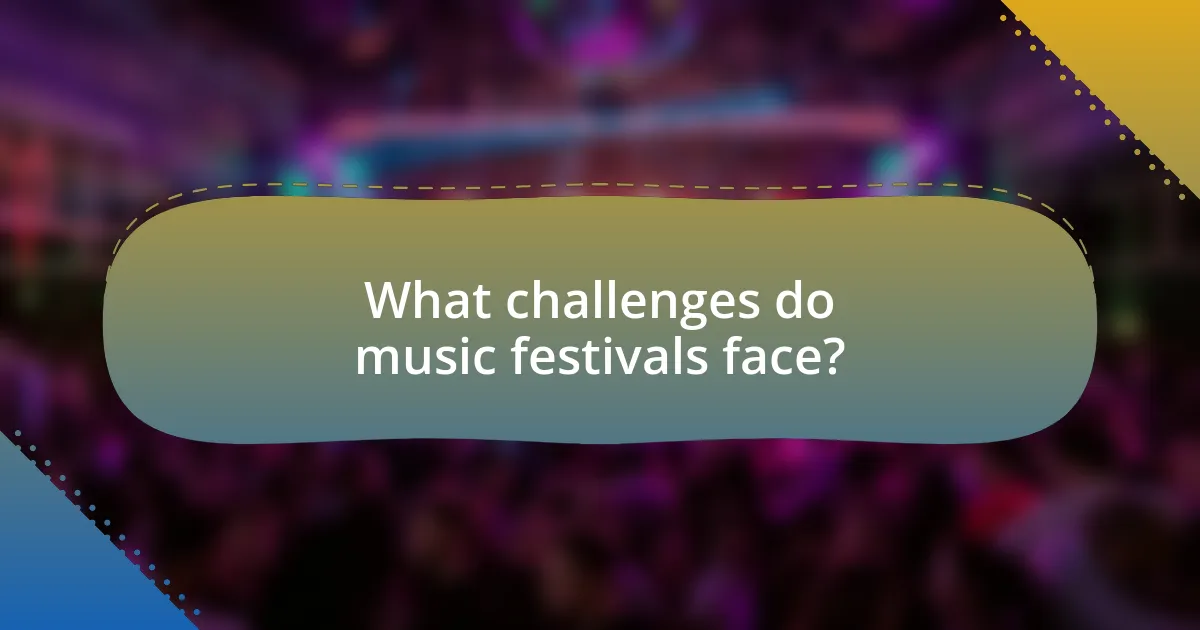
What challenges do music festivals face?
Music festivals face several significant challenges, including logistical issues, financial constraints, and safety concerns. Logistical challenges involve coordinating transportation, accommodations, and scheduling for artists and attendees, which can lead to operational inefficiencies. Financial constraints are prevalent, as festivals often rely on ticket sales and sponsorships, making them vulnerable to fluctuations in attendance and economic conditions; for instance, a study by the Event Safety Alliance found that 30% of festivals operate at a loss. Safety concerns, particularly regarding crowd management and emergency preparedness, have become increasingly critical, especially in light of incidents at large events, necessitating comprehensive planning and resources to ensure attendee safety.
How do economic factors impact music festivals?
Economic factors significantly impact music festivals by influencing ticket prices, sponsorship opportunities, and overall attendance. For instance, during economic downturns, disposable income decreases, leading to lower ticket sales and reduced festival budgets. According to a study by the Eventbrite Research Team, 60% of festival-goers consider ticket price a major factor in their decision to attend, indicating that economic conditions directly affect consumer behavior. Additionally, sponsorship deals often hinge on the economic climate; companies may cut marketing budgets during recessions, resulting in fewer partnerships for festivals. This interplay between economic conditions and festival dynamics illustrates how financial health shapes the music festival landscape.
What are the financial risks associated with hosting a music festival?
Hosting a music festival involves several financial risks, including high upfront costs, potential low ticket sales, and unexpected expenses. The initial investment for venue rental, artist fees, and production costs can exceed hundreds of thousands of dollars, creating significant financial pressure. If ticket sales do not meet projections, which can happen due to factors like poor weather or competing events, the festival may not generate enough revenue to cover these costs. Additionally, unforeseen expenses such as security issues, equipment failures, or health and safety regulations can further strain the budget. According to a study by the Event Safety Alliance, 70% of festivals reported financial losses due to unexpected costs, highlighting the precarious nature of festival financing.
How can festivals adapt to changing economic conditions?
Festivals can adapt to changing economic conditions by diversifying revenue streams and adjusting programming to align with audience preferences. For instance, festivals can incorporate a mix of ticket pricing strategies, such as tiered pricing or early bird discounts, to attract a broader audience during economic downturns. Additionally, they can enhance sponsorship opportunities by partnering with local businesses and brands, which can provide financial support while promoting community engagement. Historical data shows that festivals that implemented flexible budgeting and diversified their offerings, such as adding food vendors or merchandise sales, were able to maintain attendance and revenue even during economic challenges.
What environmental considerations are important for music festivals?
Environmental considerations important for music festivals include waste management, energy consumption, water usage, and biodiversity protection. Effective waste management strategies, such as recycling and composting, are essential to minimize landfill contributions; for instance, festivals like Glastonbury have implemented extensive recycling programs that achieved a 50% waste diversion rate. Energy consumption can be reduced by utilizing renewable energy sources, with events like Coachella incorporating solar power to lower their carbon footprint. Water usage must be managed to prevent depletion of local resources, and festivals can implement water conservation measures, as seen in the WaterAid partnership at various events. Lastly, protecting local biodiversity is crucial, as festivals can disrupt ecosystems; measures such as habitat restoration and careful site selection can mitigate these impacts, evidenced by the measures taken at the Bonnaroo Music and Arts Festival to preserve surrounding wildlife habitats.
How can festivals implement sustainable practices?
Festivals can implement sustainable practices by adopting waste reduction strategies, utilizing renewable energy sources, and promoting eco-friendly transportation options. For instance, festivals can minimize waste by providing recycling and composting stations, which can lead to a reduction of landfill waste by up to 50%, as evidenced by the 2019 Coachella festival’s waste management efforts. Additionally, using solar panels or wind turbines for energy can significantly decrease carbon footprints; the Glastonbury Festival has successfully integrated solar energy, reducing its reliance on fossil fuels. Furthermore, encouraging attendees to use public transport or carpooling can lower emissions; studies show that festivals promoting such initiatives can reduce transportation-related carbon emissions by 30%.
What are the benefits of eco-friendly initiatives for festivals?
Eco-friendly initiatives for festivals significantly reduce environmental impact, promoting sustainability and conservation. These initiatives help minimize waste through recycling and composting, which can lead to a reduction in landfill contributions by up to 50%, as evidenced by festivals that have implemented such practices. Additionally, using renewable energy sources, like solar power, decreases carbon emissions, contributing to cleaner air and a healthier ecosystem. Eco-friendly practices also enhance the festival’s reputation, attracting environmentally conscious attendees and sponsors, which can increase ticket sales and funding opportunities. Furthermore, these initiatives often lead to cost savings in waste management and energy consumption, providing financial benefits alongside environmental ones.
What are best practices for attending a music festival?
Best practices for attending a music festival include planning ahead, staying hydrated, and being mindful of personal safety. Planning ahead involves researching the festival schedule, mapping out stages, and knowing the location of amenities such as restrooms and food vendors. Staying hydrated is crucial, as festivals often take place in hot weather and can lead to dehydration; attendees should drink water regularly and consider bringing a refillable water bottle. Personal safety practices include keeping valuables secure, being aware of surroundings, and having a designated meeting spot in case of separation from friends. These practices enhance the overall experience and ensure a safer, more enjoyable time at the festival.

